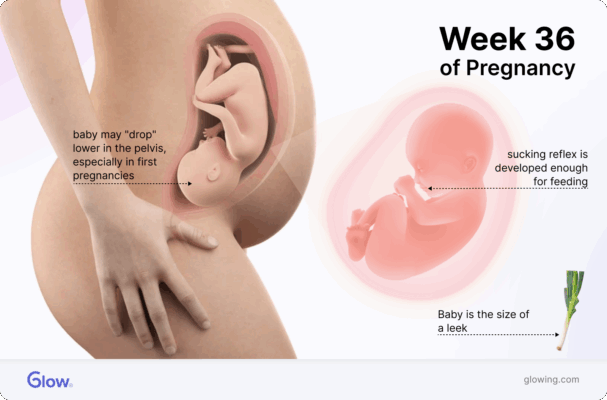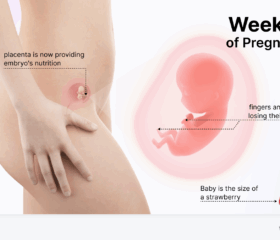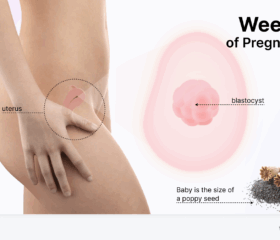Pregnancy Week by Week
36 Weeks Pregnant
Your baby is as big as a leek.
18.6
inches
5.8
pounds
- 36 Weeks Pregnant: Your Baby, Symptoms, & Preparing for Labor
- Your baby's development at 36 weeks
- Your body at 36 weeks
- Your symptoms at 36 weeks
- How to look after yourself and your baby at 36 weeks
- How to recognize the signs of labor
- What important tests are there at 36 weeks?
- What to prepare in week 36
- Final thoughts
36 Weeks Pregnant: Your Baby, Symptoms, & Preparing for Labor
As you approach the finish line, your baby is in the final stage of her development. Your body is also gearing up for labor, which will bring some new symptoms and changes to your body. Let’s explore what you can expect during this final stretch.
Your baby's development at 36 weeks
At 36 weeks, your baby is about the size of a leek, measuring approximately 18.6 inches long and weighing around 5.8 pounds. 1
While her growth is starting to slow down in preparation for delivery, several key developments are still taking place:
- Lungs: Your baby’s lungs are most likely fully developed, and she’s ready for her first breath of real air. Her lungs will expand immediately after birth, allowing her to breathe independently. 2
- Bone hardening: While they aren’t completely fused, your baby’s bones are hardening. Many are still cartilage at this point; this will turn to bone over time. 3
- Digestive system: Her digestive system has fully matured, and she’s ready to digest breast milk. Your baby has also developed her sucking reflex. 34
- Lanugo: Your baby is starting to shed the lanugo—the fine baby hair that covered her body and kept her warm. 5
- Sensory development: Your baby’s hearing is becoming more acute, and she’s listening to the sounds around her. 4
Ideally, your baby is now in a head-down position, ready for birth. However, various factors (e.g., the shape of your uterus) could cause your baby to be in the breech position (feet down) even at this relatively late date. In some cases, a non-invasive version procedure may be attempted to turn the baby. 4 If this doesn’t work, you will likely need a C-section.
Changes in your baby’s movement
You may notice a shift from kicks to squirming. That’s because your baby is getting bigger faster than you are, which means she has less room to move in there.
With that said, keep a close eye on her movements. Contact your doctor if you notice her suddenly start moving less than normal or any other changes in her pattern.

Your body at 36 weeks
As you enter your final month, your body will undergo its own final preparations for labor.
You may notice some physical changes this week. These late-pregnancy symptoms will include:
- The “penguin waddle”: Your changing hormones are still causing your ligaments and joints to loosen, resulting in a change in your gait. This can lead to the classic “pregnancy waddle.”
- Pelvic pain: With your joints more flexible and the pressure of your baby’s head pushing down on your pelvis, you might get aches and pains, which you’ll often feel in the hips or groin.
- Your baby “dropping”: As your baby moves lower, you may experience “lightening.” This can result in increased pressure in your lower abdomen and sometimes sharp pains or jolts in the pelvis. On the plus side, it can also make breathing and eating easier, as your baby isn’t pushing as much on your other organs anymore.
- Swollen feet: This symptom just never ends, apparently—you might notice even more swelling in your feet and ankles, known as edema. Let your doctor know if it’s very sudden or severe (e.g., when you press your finger on the skin, the indentation remains for a few seconds to minutes) and accompanied with headache and/or vision changes.
Your symptoms at 36 weeks
At week 36, you may experience some new pregnancy symptoms alongside some of your ongoing ones:
- Cramping: You might have mild cramps, either due to Braxton Hicks contractions (“practice” contractions as your body prepares for labor), constipation, or bloating caused by the progression of your pregnancy.
- Headaches: You might suffer from more headaches this week as a result of your hormonal shifts, dehydration, or just not enough sleep. If this is getting you down, acetaminophen (Tylenol) is generally safe to take during pregnancy, though you should still speak with your doctor before using it. 6
- Dizziness: This is another common symptom, as your hormonal fluctuations cause your blood vessels to widen and relax. 7 However, if you experience frequent dizziness and the room seems like it’s spinning, let your doctor know. 8
- Digestive issues: As your baby grows, she’s putting more pressure on your digestive system, which can cause heartburn, gas, constipation, and bloating during pregnancy.
- Trouble sleeping: You may find it harder to settle into a comfortable position in bed, which can result in pregnancy insomnia.
- Nesting instinct: Some women get a surge of energy and a desire to clean and organize their homes, commonly known as the nesting instinct, late in their pregnancies. If you experience nesting during pregnancy, take advantage and get your house organized! Just don’t overdo it, and take plenty of breaks. 9
When to contact your doctor
As annoying as they can be, most of the symptoms you’ll deal with this week are normal. That being said, you should watch out for certain symptoms, as they could indicate complications.
Preeclampsia
One condition to watch out for is preeclampsia. This is characterized by high blood pressure in pregnant women.
While it’s rare, preeclampsia can cause life-threatening complications for you and your baby. Watch out for these signs: 10
- Sudden or severe swelling in your face, hands, or feet
- Vision changes (such as blurry vision or seeing flashing lights)
- Severe headaches
If you notice any of these symptoms, try not to panic. They could just be part of your normal pregnancy symptoms. Still, it’s always better to get checked out by your doctor to be sure.
Premature labor
Even though you’ve only got a week until your baby reaches full term, she’s still considered premature if she’s born now. Fortunately, with the right intensive care, her odds of survival are much higher at this stage.
If you experience any typical labor symptoms (detailed below), contact your doctor or midwife immediately.
How to look after yourself and your baby at 36 weeks
While you’ve only got a little bit longer to go, your symptoms may still be getting you down. Fortunately, there are ways you can alleviate them and ensure that you and your little one continue progressing well.
Watch what you eat
You’ll need to continue eating well so you and your baby get all the energy you’ll need for these last few weeks. But aside from keeping you both healthy, watching what you include in your pregnancy diet can alleviate some of your symptoms. If you’re dealing with heartburn, avoid spicy, fried, or highly acidic foods that can trigger it.
Moreover, try to eat earlier, as eating a large meal close to bedtime can disrupt your sleep. Aim to finish your final meal a few hours before bed.
Stay hydrated
Hopefully, you’ve been staying hydrated throughout your pregnancy, so continue doing so this week. Drinking enough water can help if you’re dealing with swelling, dizziness, and pregnancy-induced headaches (an unfortunately common symptom). If you find yourself needing to pee often at night, you can drink less water before bed to save yourself from midnight bathroom trips.
Get plenty of rest
After all you’ve been through for these past 36 weeks, you’ll need a lot of rest. If you’re struggling to get to sleep, make sure your room isn’t too stuffy, and use pillows to support your body.
You should also avoid the wrong sleeping positions during pregnancy (i.e., lying flat on your back). Side-sleeping is the best way to sleep in the third trimester, as it improves your baby’s blood flow. 11 You could sleep with a pregnancy pillow between your legs if that’s more comfortable.
Make sure you’re vaccinated
Stay up-to-date with all your important vaccinations to keep you and your baby safe.
For starters, you can get a flu vaccine while you’re pregnant, regardless of what point you’re at in your pregnancy. If you haven’t already, you should also look into getting the Tdap shot as well (usually recommended when you’re between week 27 and 36 of your pregnancy) to protect you and your baby against three serious diseases: tetanus, diphtheria, and pertussis.
How to recognize the signs of labor
As you get closer to the big day, it’s important to be able to recognize the signs that labor is close (or happening already). Here are the signs of labor you should look out for:
Lightening
Once you’re closer to the due date, your belly may look as though it’s lower and you might find breathing becomes easier. Again, this is known as “lightening,” and it occurs when your baby’s head “drops” into your pelvis.
First-time moms may notice this weeks before labor, whereas if you’ve had kids before, you might not feel it until labor actually begins. 12
Bloody show
Many women see what’s known as “bloody show.” It sounds scary, but it’s perfectly normal.
When you get closer to your due date, your cervix starts opening (cervical dilation), causing blood and mucus to mix into your vaginal discharge. If it happens, don’t panic—it just means your body is getting ready for labor. However, it may still be a few days before it actually happens. 12
Your water breaking
You’ve probably heard of your water breaking before. When the amniotic sac (the bag of fluid that surrounds your baby) breaks, the amniotic fluid will leak or gush out.
Amniotic fluid is usually clear or pale yellow in color and is either odorless or slightly sweet-smelling.
You should tell your doctor or midwife straight away if your water breaks, but it’s especially important to let them know if any of the amniotic fluid is tinged with green or brown. This could mean that your baby has passed meconium (her first poop), which can happen if she’s distressed. 13
If she is, it could mean you have some sort of pregnancy complication that requires special treatment, although it’ll more than likely be a minor, eminently treatable one.
Contractions
Another clear sign that you’re going into labor is that you’re having regular contractions that feel very painful.
It’s possible to mistake Braxton Hicks contractions for the real deal, but there are several key differences. Check out the table below for a breakdown: 14
Differences between true labor contractions and Braxton Hicks contractions
| Characteristic | True labor contractions | Braxton Hicks contractions |
|---|---|---|
| Pain | - Very painful - Get more intense over time |
- Not usually painful |
| Frequency | - Regular (intervals of 10 minutes or less) - Don’t subside no matter what you do |
- Irregular - Usually subside when you change positions, drink fluids, or take a walk |
| Length | - Usually last 30–70 seconds | - Usually last 15–30 seconds (though sometimes up to 2 minutes) |
| Other signs of labor | - Are accompanied by other signs of labor | - Aren’t accompanied by other signs of labor |
You can try timing your contractions with a pregnancy tracker app to discern whether they’re the result of labor or not.
What important tests are there at 36 weeks?
Once you reach 36 weeks, you’ll start seeing your doctor every week. With your due date just around the corner, they’ll perform a few essential tests:
- Group B strep test: Around week 36 or 37, you’ll be tested for Group B strep (GBS). This bacteria is usually harmless to adults but can cause serious infections in newborns. If you test positive, you’ll receive antibiotics during labor to protect your baby. 15
- Ultrasound: Your doctor may check your baby’s position using an ultrasound. They may also use an ultrasound to monitor your baby’s health, especially if you have a high-risk pregnancy or are pregnant with multiples.
Do you need a cervical check?
Your doctor might ask if you want a cervical check around weeks 36 or 37. This involves examining your cervix manually.
Cervical checks aren’t always necessary, but it might be good to have one if:
- You’re having an induction (when a doctor or midwife artificially starts labor)
- You need to address certain pregnancy complications, such as bleeding (subchorionic hematoma) or premature rupture of the amniotic membranes
- You’re not sure whether labor has started or not
- You need specialized care during labor for some other reason
You have the right to refuse a cervical check. It can be an uncomfortable exam and may increase the risk of bacteria entering your cervix.
However, doctors don’t generally recommend them without a good reason. If yours does, talk about why and make your decision.
What to prepare in week 36
You may be feeling extra tired this week, but unfortunately, there are a few things you still need to prepare before the big day arrives. Here’s your homework:
- Pack your hospital bag: Prepare your hospital bag with essentials like toiletries, comfortable clothing, a going-home outfit for your baby, and your phone charger. Don’t worry about packing diapers, bottles, or too many baby clothes—the hospital should provide these.
- Install your baby’s car seat: Make sure you install your infant car seat correctly, closely following the manufacturer’s instructions. You can always get a car seat technician to help you if you don’t feel confident doing it yourself.
- Finalize your birth plan: If you have a birth plan, review it with your doctor or midwife to ensure everyone’s clear on what it consists of.
- Make food for after delivery: You’ll be busy when your newborn comes home, so prepare your meals ahead of time and freeze them. If you have any budding chefs among your family and friends, you could also ask them to help you.
- Find a pediatrician: If you haven’t already, find a pediatrician for your baby. You’ll need to see them soon after delivery, so it’s best to choose your little one’s doctor before your baby arrives and everything becomes much more chaotic.
To stay on top of things, consider using a pregnancy app. The best pregnancy trackers have to-do lists, hospital bag checklists, and birth plan creators to keep you organized.
Final thoughts
The final weeks of your pregnancy can be challenging, but just remember how close you are to the finish line. Get plenty of rest, make all the necessary preparations for labor and delivery, and keep in close contact with your doctor or midwife.
Enjoy these last few weeks, and celebrate all the hard work you’ve done up to this point. It won’t be long before you’re cuddling your little one—as well as waking up to their cries in the middle of the night!
Article Sources
- Baby Your Baby. "Fetal Growth Chart" Retrieved June 26, 2025.
- National Health Service. "Week 36" Retrieved June 26, 2025.
- The Birth Company. "Week 36 of pregnancy (Days 252-258)" Retrieved June 26, 2025.
- Johns Hopkins Medicine. "The Third Trimester" Retrieved June 26, 2025.
- StatPearls. "Anatomy, Hair Follicle" Retrieved June 26, 2025.
- PLOS One. "Maternal use of acetaminophen during pregnancy and neurobehavioral problems in offspring at 3 years: A prospective cohort study" Retrieved June 26, 2025.
- American Pregnancy Association. "Dizziness During Pregnancy" Retrieved June 26, 2025.
- Cureus. "Vertigo in Pregnancy: A Narrative Review" Retrieved June 26, 2025.
- Cleveland Clinic. "Nesting Instinct When Pregnant" Retrieved June 26, 2025.
- MedlinePlus. "Preeclampsia" Retrieved June 26, 2025.
- MedlinePlus. "Problems sleeping during pregnancy" Retrieved June 26, 2025.
- MedlinePlus. "Am I in labor?" Retrieved June 26, 2025.
- Pregnancy, Birth and Baby. "Giving birth - waters breaking" Retrieved June 26, 2025.
- UNM Health Sciences Center. "Common Discomforts During Pregnancy" Retrieved June 26, 2025.
- American College of Obstetricians and Gynecologists. "Group B Strep and Pregnancy" Retrieved June 26, 2025.







